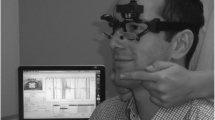Abstract
The vHIT (video head impulse test) investigates the vestibular function in two ways: a VOR (vestibulo-ocular reflex) gain value and a head impulse diagram. From the diagram covert and overt saccades can be detected. Evaluation of the vestibular function based on vHIT depends on both parameters. There is a lack of knowledge regarding the reliability of the two parameters. The objective was to investigate the reliability of vHIT by comparing gain values between examiners on the same subjects, and to see how differences affected the occurrence of saccades. Subjects: 25 subjects who had undergone cochlear implant (CI) surgery. Subjects were tested using the vHIT by two of four different examiners. Two judges interpreted the occurrence of saccades in the diagram. Main Outcome Measures: VOR gain values and the occurrence of saccades in the diagram. Differences in gain values between examiners varied from 0.2 to 0.58 with an average of 0.14 (95 % CI 0.12–0.16) on the right ear and 0.17 (95 % CI 0.15–0.19) on the left ear. Occurrences of saccades in the same patient were reproduced in 93 % of the cases by all examiners. Kappa’s coefficient on the occurrence of saccades was 0.83. Interclass correlation coefficient (ICC) of the gain values between examiners ranged from 0.62 to 0.70. Differences in gain values amongst examiners did not seem to affect the occurrence of saccades in the same patient. The occurrence of saccades, therefore, seems to be more reliable than the gain value in the evaluation of the vestibular function. Interpretation of vHIT results should, therefore, first depend on the occurrence of saccades and second on the gain value.
Similar content being viewed by others
References
Curthoys IS, MacDougall HG, Manzari L, Burgess AM, Bradshaw AP, McGarvie L, Halmagyi GM, Weber KP (2011) Clinical application of a new objective test of semicircular canal dynamic function—the video head impulse test (vHIT)
MacDougall HG, Weber KP, McGarvie LA, Halmagyi GM, Curthoys IS (2009) The Video Head impulse test: diagnostic accuracy in peripheral vestibulopathy. Neurology 73(14):1134–1141
Bronstein AM, Patel M, Arshad Q (2015) A brief review of the clinical anatomy of the vestibular-ocular connections—how much do we know? Eye. 29:163–170
Fetter M (2007) Vestibulo-ocular reflex. Dev Ophthalmol 40:35–51
Beynon GJ, Jani P, Baguley DM (1998) A clinical evaluation of head impulse testing. Clin Otolaryngol Allied Sci 23(2):117–122
EyeSeeCam booklet. http://www.interacoustics.com/eyeseecam/support. Accessed Nov 2015
MacDougall HG, McGarvie LA, Halmagyi GM, Curthoys IS, Weber KP (2013) The video head impulse test (vHIT) detects vertical semicircular canal dysfunction. PLoS One 8(4):e61488
Blöwdow A, Pannasch S, Walther LE (2013) Detection of isolated covert saccades with the video head impulse test in peripheral vestibular disorders. Auris Nasus Larynx 40(4):348–351
Aw ST, Haslwanter T, Halmagyi GM, Curthoys IS, Yavor RA, Todd MJ (1996) Three-dimensional vector analysis of the human vestibuloocular reflex in response to high-acceleration head rotations, I: responses in normal subjects. J Neurophysiol 76:4009–4020
Matiño-Soler E, Esteller-More E, Martin-Sanchez JC, Martinez-Sanchez JM, Perez-Sanchez N (2015) Normative data on angular vestibulo-ocular responses in the yaw axis measured using the video head impulse test. Otol Neurotol 36(3):466–471
Mossman B, Mossman S, Purdie G, Schneider E (2015) Age dependent normal horizontal VOR gain of head impulse test as measured with video-oculography. J Otolaryngol Head Neck Surg. 4(44):29
Interacoustics webinar “Video Head Impulse Testing: Interpretation”. http://www.interacoustics.com/webinars#balance. Accessed June 2015
Mabrey H, Murnane O, Pearson A, Byrd S, Akin (2014) Normative data and test-retest reliability of the SYNAPSIS video head impulse test. J Am Acad Audiol 25(3):244–252
Ulmer E, Bernard-Demanze L, Lacour M (2011) Statistical study of normal canal deficit variation range. Measurement using the head impulse test video system. Eur Ann Otorhinolaryngol Head Neck Dis 128:278–282
Kidd C, Byrd S, Riska K, Murnane O, Akin F (2015) Intra- and inter-examiner reliability of the video head impulse test. http://www.icsimpulse.com/cases-and-research/Inter-and-Intra-Examiner-Reliability,-sp-,-for-ICS-Impuls. Accessed June 2015
Patterson JN, Bassett AM, Mollak CM, Honaker JA (2015) Effects of hand placement technique on the video head impulse test (vHIT) in younger and older adults. Otol Neurotol. 36(6):1061–1068
McGarvie LA, MacDougall HG, Halmagyi GM, Burgess AM, Weber KP, Curthoys IS (2015) The video head impulse test (vHIT) of semicircular canal function—age-dependent normative values of VOR gain in healthy subjects. Front Neurol 6:154. doi:10.3389/fneur.2015.00154
Author information
Authors and Affiliations
Corresponding author
Ethics declarations
The study is sponsored by the Oticon Foundation, MED-EL G.m.b.H and Danaflex a/s.
Conflict of interest
The authors declare no other conflict of interest.
All procedures performed in this study were in accordance with the ethical standards of the Regional Committees on Health Research Ethics for Southern Denmark.
Informed consent was obtained from all individual participants included in the study.
Rights and permissions
About this article
Cite this article
Korsager, L.E.H., Schmidt, J.H., Faber, C. et al. Reliability and comparison of gain values with occurrence of saccades in the EyeSeeCam video head impulse test (vHIT). Eur Arch Otorhinolaryngol 273, 4273–4279 (2016). https://doi.org/10.1007/s00405-016-4183-2
Received:
Accepted:
Published:
Issue Date:
DOI: https://doi.org/10.1007/s00405-016-4183-2




